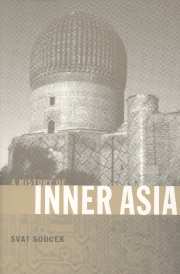Book contents
- Frontmatter
- Contents
- List of maps
- Preface
- Introduction
- 1 The beginnings
- 2 The Kök Turks, the Chinese expansion, and the Arab conquest
- 3 The Samanids
- 4 The Uighur kingdom of Qocho
- 5 The Qarakhanids
- 6 Seljukids and Ghaznavids
- 7 The conquering Mongols
- 8 The Chaghatayids
- 9 Timur and the Timurids
- 10 The last Timurids and the first Uzbeks
- 11 The Shaybanids
- 12 The rise of Russia, the fall of the Golden Horde, and the resilient Chaghatayids
- 13 The Buddhist Mongols
- 14 Bukhara, Khiva, and Khoqand in the seventeenth to nineteenth centuries
- 15 The Russian conquest and rule of Central Asia
- 16 From Governorates-General to Union Republics
- 17 Soviet Central Asia
- 18 Central Asia becomes independent
- 19 Sinkiang as part of China
- 20 Independent Central Asian Republics
- 21 The Republic of Mongolia
- Summary and conclusion
- Appendix 1 Dynastic tables
- Appendix 2 Country data
- Select bibliography
- Index
15 - The Russian conquest and rule of Central Asia
Published online by Cambridge University Press: 05 June 2012
- Frontmatter
- Contents
- List of maps
- Preface
- Introduction
- 1 The beginnings
- 2 The Kök Turks, the Chinese expansion, and the Arab conquest
- 3 The Samanids
- 4 The Uighur kingdom of Qocho
- 5 The Qarakhanids
- 6 Seljukids and Ghaznavids
- 7 The conquering Mongols
- 8 The Chaghatayids
- 9 Timur and the Timurids
- 10 The last Timurids and the first Uzbeks
- 11 The Shaybanids
- 12 The rise of Russia, the fall of the Golden Horde, and the resilient Chaghatayids
- 13 The Buddhist Mongols
- 14 Bukhara, Khiva, and Khoqand in the seventeenth to nineteenth centuries
- 15 The Russian conquest and rule of Central Asia
- 16 From Governorates-General to Union Republics
- 17 Soviet Central Asia
- 18 Central Asia becomes independent
- 19 Sinkiang as part of China
- 20 Independent Central Asian Republics
- 21 The Republic of Mongolia
- Summary and conclusion
- Appendix 1 Dynastic tables
- Appendix 2 Country data
- Select bibliography
- Index
Summary
The time, manner, and purpose of this conquest can be divided into two stages: in the first, Russia acquired the greater part of Kazakhstan except its Semireche and Syr Darya – thus southernmost – segments; in the second, the latter two and all the rest, thus territories of present-day Uzbekistan, Kyrgyzstan, Tajikistan, and Turkmenistan. The earlier stage was longer and more gradual (1730–1848), and at certain points structurally resembled the preceding acquisition of Siberia (which in turn could be viewed as an analogy to the “winning of the West” by the United States); the later stage was relatively brief – lasting from 1864 to 1884, the decisive move, however, being compressed into several campaigns between 1865 and 1868 – and stood squarely in the psychological context of Europe's contemporary “scramble for the colonies.”
By 1730 the Kazakhs, as we have seen, had asserted themselves as a distinct group of nomadic tribes living in the eastern part of the Dasht-i Kipchak, speaking a distinctive Kipchak Turkic idiom, but lacking overall political unity. As a somewhat peculiar substitute for the latter, though, the tribes had coalesced into three confederations, the aforementioned Greater, Middle, and Lesser Hordes. Geography as much as tribal politics no doubt played a role in their formation: the Greater Horde occupied a territory roughly coterminous with Semireche, the Middle Horde that of central Kazakhstan, and the Lesser Horde that of western Kazakhstan.
- Type
- Chapter
- Information
- A History of Inner Asia , pp. 195 - 208Publisher: Cambridge University PressPrint publication year: 2000



